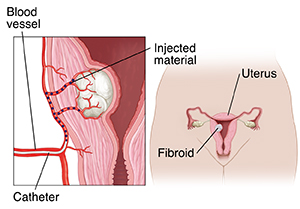Uterine Fibroid Embolization
Uterine fibroid embolization is a procedure that is done to shrink a fibroid. Fibroids are benign (not cancerous) growths of muscle tissue on or inside the uterus. This procedure stops the blood supply to the fibroid. It is often done by a specially trained healthcare provider called an interventional radiologist. This type of healthcare provider is specially trained and certified by the American Board of Radiology to use minimally invasive image-guided procedures to diagnose and treat diseases.

Before your procedure
To get ready for your procedure:
-
Follow any directions you’re given for not eating or drinking before the procedure.
-
Tell your healthcare provider if you are allergic to any foods, medicines, or X-ray dye (contrast medium).
-
Tell your healthcare provider about any recent illnesses or if you have medical conditions.
Tell your healthcare provider about any medicines you are taking. You may need to stop taking all or some of these before the procedure. This includes:
-
All prescription medicines
-
Herbs, vitamins, and other supplements
-
Over-the-counter medicines, such as aspirin or ibuprofen
-
Illegal drugs
During your procedure
-
You will lie on an X-ray table. An IV (intravenous) line is put into a vein in your arm or hand. This line gives you fluids and medicines. You may be given medicine to relax you and make you sleepy.
-
Medicine will be put on the skin on your groin to numb it. Then a small cut or incision is made. A needle is put through the incision into the artery in your groin. A wire is then advanced farther into the artery.
-
A thin, flexible tube called a catheter is placed over the guide wire into the blood vessel.
-
X-ray dye is injected through the catheter. This helps the blood vessels and catheter show up better on X-ray images. The catheter’s movement can be seen on a computer screen.
-
The radiologist uses X-ray images (fluoroscopy) as a guide. They move the catheter through the blood vessel. It is moved into the artery that supplies blood to your uterus.
-
The catheter is moved near the fibroid. The radiologist then injects tiny grains of plastic or spongy material into the artery. These grains flow to the smaller blood vessels that supply the fibroid. Blood flow to these vessels is blocked. The procedure is done again on the other side of your uterus.
-
The entire procedure takes about 1 to 2 hours.
After your procedure
You may stay in the hospital overnight. You will likely feel pain and cramping for up to 1 week. Medicines will be prescribed to help control this pain. Some vaginal bleeding, also called spotting, is common for a few days. You may feel tired and have an upset stomach and a fever for a few days after the procedure. During your recovery, care for the incision as directed. You may be able to return to work 1 to 2 weeks after the procedure. Your healthcare provider will tell you more.
Possible risks
All procedures have some risk. Possible risks of uterine fibroid embolization include:
-
Infection or bruising around the catheter insertion site
-
Blood clot in a blood vessel
-
Problems because of X-ray dye. These include allergic reaction or kidney damage.
-
Not being able to have a baby (infertility) or going into early menopause.
-
Injury to the uterus. This might need a procedure to remove tissue from the uterus (dilation and curettage). Or the uterus itself might need to be removed (a hysterectomy).
-
Exposure to X-ray radiation. This is typically low level and considered safe.
-
Return of fibroid symptoms. Or new fibroids can develop in the future.
-
Postembolization syndrome. This condition may last 2 to 7 days. It may cause pelvic pain, cramping, vaginal discharge, nausea and vomiting, low-grade fever, fatigue, and discomfort. It's treated with pain medicine and anti-inflammatory medicines.
Experts don't know how this procedure affects a woman's ability to have a baby (fertility) in the long term. They also don't know how it affects future pregnancies.
Online Medical Reviewer:
Neil Grossman MD
Online Medical Reviewer:
Rita Sather RN
Online Medical Reviewer:
Tara Novick BSN MSN
Date Last Reviewed:
12/1/2022
© 2000-2025 The StayWell Company, LLC. All rights reserved. This information is not intended as a substitute for professional medical care. Always follow your healthcare professional's instructions.